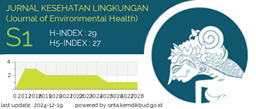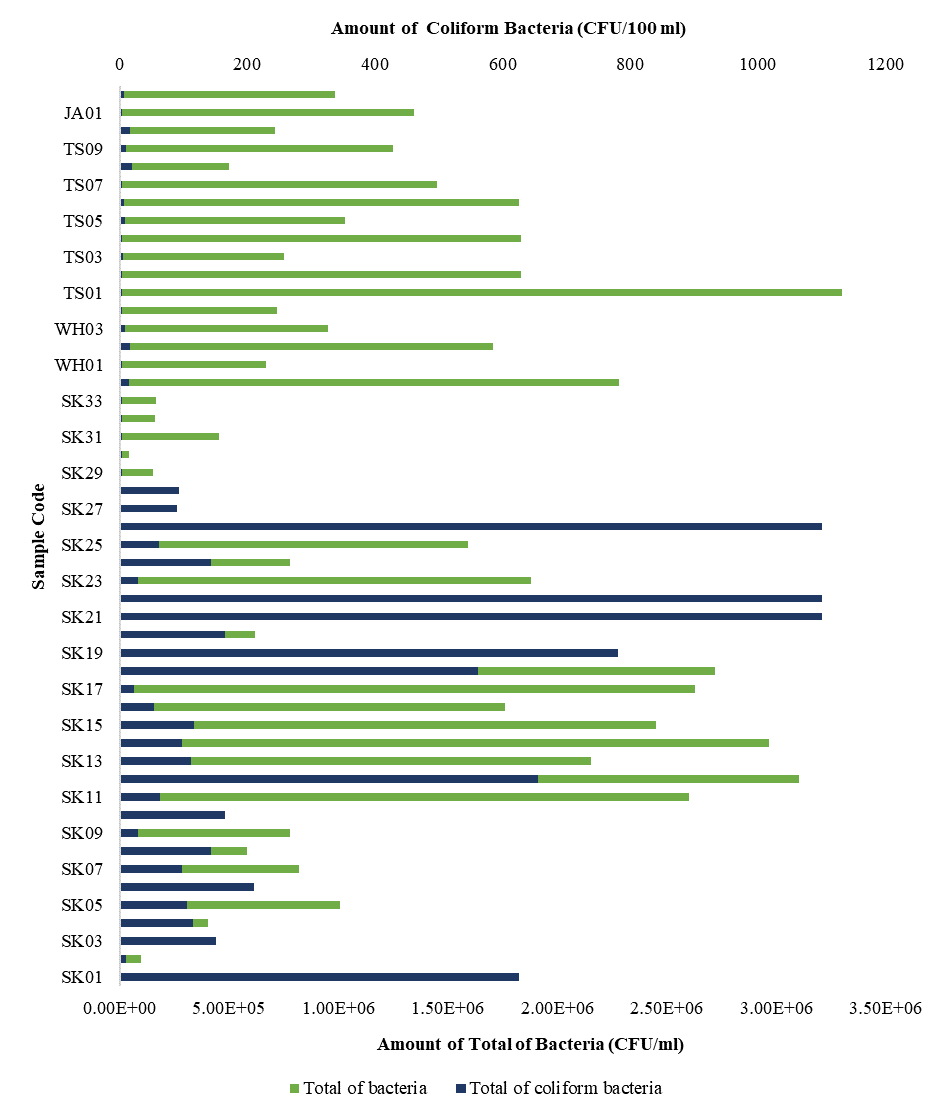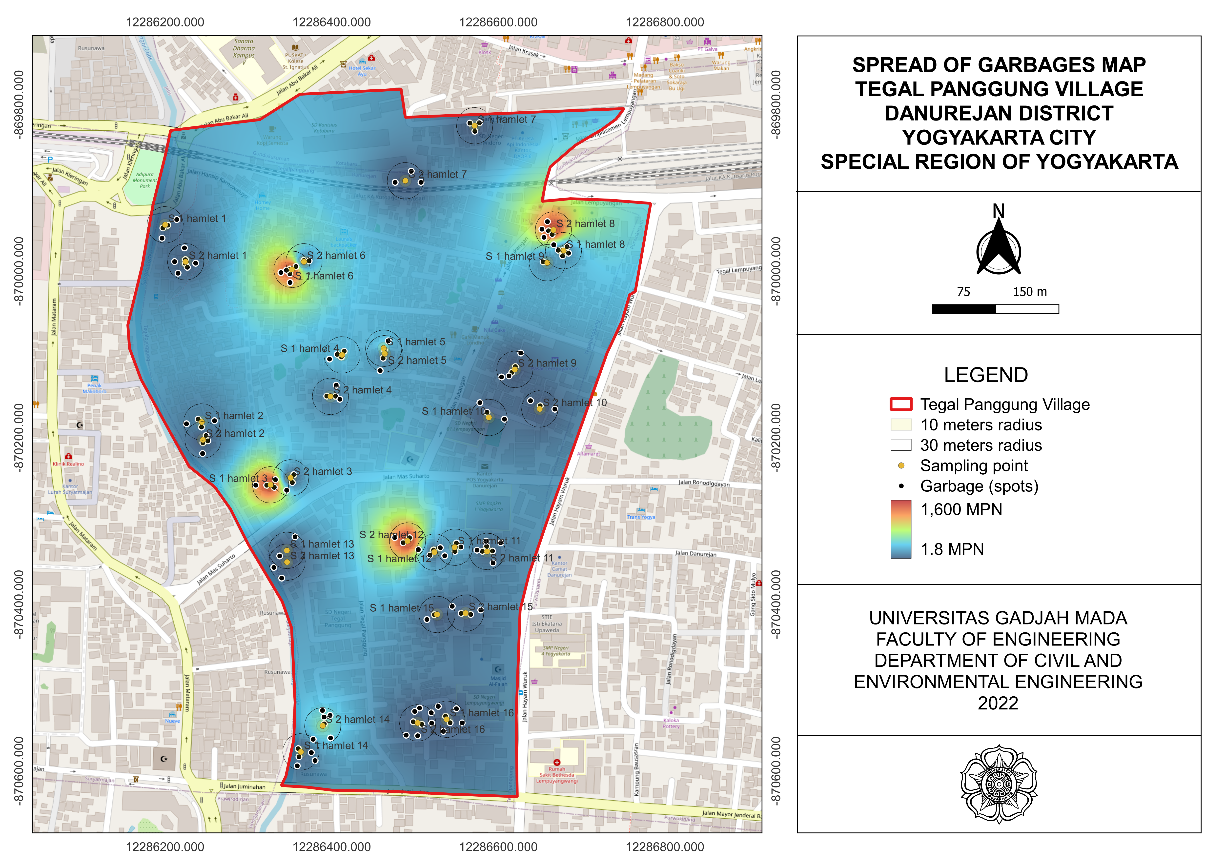Health Risks Assessment of Heavy Metal from Consumption of Oreochromis Mossambicus and Oreochromis Niloticus in Denpasar, Bali
Downloads
Jaishankar M, Tseten T, Anbalagan N, Mathew BB, Beeregowda KN. Toxicity, Mechanism and Health Effects of Some Heavy Metals. Interdisciplinary toxicology. 2014;7(2):60-72. https://dx.doi.org/10.2478%2Fintox-2014-0009
Srivastava A, Siddiqui NA, Koshe RK, Singh VK. Human Health Effects Emanating from Airborne Heavy Metals Due to Natural and Anthropogenic Activities: A Review. Singapore: Springer; 2018. https://link.springer.com/chapter/10.1007/978-981-10-7122-5_29
Ali H, Khan E. Assessment of Potentially Toxic Heavy Metals and Health Risk in Water, Sediments, and Different Fish Species of River Kabul, Pakistan. Human and Ecological Risk Assessment: An International Journal. 2018;24(8):2101-2118. https://doi.org/10.1080/10807039.2018.1438175
Liu M, Xu Y, Nawab J, Rahman Z, Khan S, Idress M, et al. Contamination Features, Geo-Accumulation, Enrichments and Human Health Risks Of Toxic Heavy Metal(loids) from Fish Consumption Collected Along Swat River, Pakistan. Environmental Technology & Innovation. 2020;17(1):100554. https://doi.org/10.1016/j.eti.2019.100554
Barone G, Dambrosio A, Storelli A, Garofalo R, Busco VP, Storelli MM. Estimated Dietary Intake of Trace Metals From Swordfish Consumption: A Human Health Problem. Toxics. 2018;6(22):1-11. https://doi:10.3390/toxics6020022
Taylor AA, Tsuji JS, Garry MR, McArdle ME, Goodfellow WL, Adams WJ, et al. Critical Review of Exposure and Effects: Implications for Setting Regulatory Health Criteria for Ingested Copper. Environmental Management. 2020;65(1):131-159. https://doi.org/10.1007/s00267-019-01234-y
Zhong W, Zhang Y, Wu Z, Yang R, Chen X, Yang J, et al. Health Risk Assessment of Heavy Metals in Freshwater Fish in the Central and Eastern North China. Ecotoxicology and Environmental Safety. 2018;157(1):343-349. https://doi.org/10.1016/j.ecoenv.2018.03.048
United States Environmental Protection Agency. Integrated Risk Information System. United States: Environmental Protection Agency; 2021. https://www.epa.gov/iris
Kumar A, Kumar A, Cabral-Pinto, Chaturvedi AK, Shabnam AA, Subrahmanyam G, et al. Lead Toxicity: Health Hazards, Influence on Food Chain, and Sustainable Remediation Approaches. IJERPH. 2020;17(7):2179. https://doi.org/10.3390/ijerph17072179
Genchi G, Sinicropi MS, Lauria G, Carocci A, Catalano A. The Effects of Cadmium Toxicity. IJERPH. 2020;17(11):3782. https://dx.doi.org/10.3390%2Fijerph17113782
Javed M, Usmani N. Accumulation of Heavy Metals and Human Health Risk Assessment via the Consumption of Freshwater Fish Mastacembelus Armatus Inhabiting, Thermal Power Plant Effluent Loaded Canal. SpringerPlus. 2016;5(776):1-8. https://doi.org/10.1186/s40064-016-2471-3
Jezierska B, Witeska M. The Metal Uptake and Accumulation in Fish Living in Polluted Waters. Soil and Water Pollution Monitoring, Protection and Remediation. Dordrecht: Springer; 2006. p. 107-14. https://doi.org/10.1007/978-1-4020-4728-2_6
National Agency of Drug and Food Control of Indonesia (BPOM). Regulation of National Agency of Drug and Food Control of Indonesia No. 23 of 2017 concering Maximum Limit of Heavy Metal Contamination in Processed Food. Jakarta: National Agency of Drug and Food Control of Indonesia (BPOM); 2017.
Food and Agriculture Organization of the United Nations & World Health Organization. Evaluation of Certain Food Additives and Contaminants: Thirty-Third Report of the Joint FAO/WHO Expert Committee on Food Additives ["ŽMeeting Held In Geneva From 21 to 30 March 1988]. Geneva: Food and Agriculture Organization of the United Nations & World Health Organization; 1989. https://apps.who.int/iris/bitstream/handle/10665/39252/WHO_TRS_776.pdf?sequence=1&isAllowed=y
Sari AHW. Histopatologi Insang Ikan Bandeng (Chanos chanos) yang Tertangkap di Muara Tukad Badung, Bali. Journal of Marine and Aquatic Sciences. 2019;5(2):219-222. https://ojs.unud.ac.id/index.php/jmas/article/download/51646/30625
Sari AHW, Perwira IY. Biomarker Histopatologi Hati Ikan Belanak (Mugil cephalus) sebagai Peringatan Dini Toksisitas Kromium (Cr) di Muara Tukad Badung, Bali. Journal of Marine and Aquatic Sciences. 2019;5(2):229-233. https://ojs.unud.ac.id/index.php/jmas/article/download/51704/30662
Kusumadewi MR, Suyasa IWB, Berata IK. Tingkat Biokonsentrasi Logam Berat dan Gambaran Histopatologi Ikan Mujair (Oreochromis Mossambicus) yang Hidup di Perairan Tukad Badung Kota Denpasar. ECOTROPHIC. 2015;9(1):25-34. https://doi.org/10.24843/EJES.2015.v09.i01.p04
Selmi S, Wiharto W, Patang P. Analisis Air, Substrat Tanah dan Cemaran Logam Berat Timbal (Pb) dan Cadmium (Cd) Pada Ikan Nila (Oreochromis Niloticus) Pada Waduk Tunggu Pampang Kelurahan Bitoa, Kota Makassar. Jurnal Pendidikan Teknologi Pertanian. 2019;5(2):36-46. http://103.76.50.195/ptp/article/download/9626/5624
The Department of Health of Australia. Environmental Health Risk Assessment: Guidelines for Assessing Human Health Risks from Environmental Hazards Australia. Victoria: The Department of Health of Australia; 2012. https://www1.health.gov.au/internet/main/publishing.nsf/Content/A12B57E41EC9F326CA257BF0001F9E7D/$File/Environmental-health-Risk-Assessment.pdf
Ayanda IO, Ekhator UI, Bello OA. Determination of Selected Heavy Metal and Analysis of Proximate Composition in Some Fish Species from Ogun River, Southwestern Nigeria. Heliyon. 2019;5(10):e02512. https://doi.org/10.1016/j.heliyon.2019.e02512
Xie Q, Qian L, Liu S, Wang Y, Zhang Y, Wang D. Assessment of Long-Term Effects from Cage Culture Practices on Heavy Metal Accumulation in Sediment and Fish. Ecotoxicology and Environmental Safety. 2020;194(1):110433. https://doi.org/10.1016/j.ecoenv.2020.110433
Mehmood MA, Qadri H, Bhat RA, Rashid A, Ganie SA, Dar GH, et al. Heavy Metal Contamination in Two Commercial Fish Species of A Trans-Himalayan Freshwater Ecosystem. Environmental Monitoring and Assessment. 2019;191(104):1-16. https://doi.org/10.1007/s10661-019-7245-2
Mardani NPS, Restu IW, Sari AHW. Kandungan Logam Berat Timbal (Pb) dan Kadmium (Cd) Pada Badan Air dan Ikan di Perairan Teluk Benoa, Bali. Current Trends in Aquatic Science I. 2018;1(1):106-113. https://ojs.unud.ac.id/index.php/CTAS/article/download/43045/27824
Maurya PK, Malik DS, Yadav KK, Kumar A, Kumar S, Kamyab H. Bioaccumulation and Potential Sources of Heavy Metal Contamination in Fish Species in River Ganga Basin: Possible Human Health Risks Evaluation. Toxicology Reports. 2019;6(1):472-481. https://doi.org/10.1016/j.toxrep.2019.05.012
ÅuczyÅ„ska J, Paszczyk B, ÅuczyÅ„ski MJ. Fish as a Bioindicator of Heavy Metals Pollution in Aquatic Ecosystem of Pluszne Lake, Poland, and Risk Assessment for Consumer's Health. Ecotoxicology and Environmental Safety. 2018;153(1):60-67. https://doi.org/10.1016/j.ecoenv.2018.01.057
Liu X, Jiang J, Yan Y, Dai Y, Deng B, Ding S, et al. Distribution and Risk Assessment of Metals in Water, Sediments, and Wild Fish from Jinjiang River in Chengdu, China. Chemosphere. 2018;196(1):45-52. https://doi.org/10.1016/j.chemosphere.2017.12.135
Raharjo P, Raharjo M, Setiani O. Analisis Risiko Kesehatan dan Kadar Timbal Dalam Darah:(Studi Pada Masyarakat yang Mengkonsumsi Tiram Bakau (Crassostrea gigas) di Sungai Tapak Kecamatan Tugu Kota Semarang). Jurnal Kesehatan Lingkungan Indonesia. 2018;17(1):9-15. https://doi.org/10.14710/jkli.17.1.9-15
Gwimbi P, Kotelo Ta, Selimo MJ. Heavy Metal Concentrations in Sediments and Cyprinus Carpio from Maqalika Reservoir –Maseru, Lesotho: An Analysis of Potential Health Risks to Fish Consumers. Toxicology Reports. 2020;7(1):475-479. https://doi.org/10.1016/j.toxrep.2020.03.005
Gbogbo F, Arthur-Yartel A, Bondzie JA, Dorleku W-P, Dadzie S, Kwansa-Bentum B, et al. Risk of Heavy Metal Ingestion from the Consumption of Two Commercially Valuable Species of Fish from the Fresh and Coastal Waters of Ghana. PLOS ONE. 2018;13(3):e0194682. https://doi.org/10.1371/journal.pone.0194682
2. Formal legal provisions to access digital articles of electronic journal are subject to the provision of the Creative Commons Attribution-ShareAlike license (CC BY-NC-SA), which means that Jurnal Kesehatan Lingkungan is rightful to keep, transfer media/format, manage in the form of databases, maintain, and publish articles.
3. Published manuscripts both printed and electronic are open access for educational, research, and library purposes. Additionally, the editorial board is not responsible for any violations of copyright law.
JKESLING by UNAIR is licensed under a Creative Commons Attribution-ShareAlike 4.0 International License.







































